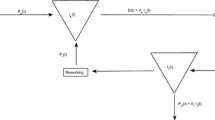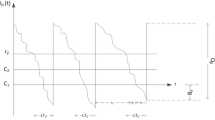Abstract
The present paper is devoted to modeling and solving the inventory and production planning in a four-echelon supply chain (SC) with reverse logistics, from supplier to after-sales service center and repair center. To the best of our knowledge, this is the first scientific attempt for modeling and resolving the inventory and production planning in an SC with reverse logistics that the problem is modeled by a disturbance optimal control problem (OCP). Both recycling and reworking are assumed in the reverse logistic. There was a disturbance because we considered the demand time-dependent. From the former points the presented model is so close to the real-world problem in the field of SC. The Pontryagin minimum principle is applied to reformulate the OCP into a system of equations. In continuous, the system of equations is solved by an artificial neural network. In the final step, an example and a case study are presented to depict the performance and validity of the model and the method.






Similar content being viewed by others
References
Garg K, Kannan D, Diabat A, Jha PC (2015) A multi-criteria optimization approach to manage environmental issues in closed loop supply chain network design. J Clean Prod 100:297–314
Giri BC, Sharma S (2015) Optimizing a closed-loop supply chain with manufacturing defects and quality dependent return rate. J Manuf Syst 35:92–111
Soleimani H, Kannan G (2015) A hybrid particle swarm optimization and genetic algorithm for closed-loop supply chain network design in large-scale networks. Appl Math Model 39(14):3990–4012
Shohan S, Ali SM, Kabir G, Ahmed SK, Suhi SA, Haque T (2019) Green supply chain management in the chemical industry: structural framework of drivers. Int J Sustain Dev World Ecol 26:752–768
Ahi P, Searcy C (2013) A comparative literature analysis of definitions for green and sustainable supply chain management. J Clean Prod 52:329–341
Cousins PD, Lawson B, Petersen KJ, Fugate B (2019) Investigating green supply chain management practices and performance: The moderating roles of supply chain ecocentricity and traceability. Int J Oper Prod Manag 39:767–786
Zhu W, He Y (2017) Green product design in supply chains under competition. Eur J Oper Res 258:165–180
Franchetti M, Elahi B, Ghose S (2017) Green supply chain, logistics, and transportation. In: Machado C, Davim J (eds) Green and Lean Management. Management and Industrial Engineering. Springer, Cambridge
Tseng M-L, Islam MS, Karia N, Fauzi FA, Afrin SA (2019) literature review on green supply chain management: Trends and future challenges. Resour Conserv Recyc 141:145–162
Maditati DR, Munim ZH, Schramm H-J, Kummer SA (2018) A review of green supply chain management: From bibliometric analysis to a conceptual framework and future research directions. Resourc Conserv Recyc 139:150–162
Sethi SP, Thompson GL (2000) Optimal control theory, applications to management science and economics, 2nd edn. Springer, Berlin
Kistner K-P, Dobos I (2000) Optimal production-inventory strategies for a reverse logistics system. Optim Dyn Econ Anal. Physica-Verlag, HD
Pooya A, Pakdaman M (2021) A new continuous time optimal control model for manpower planning with promotion from inside the system. Int J Oper Res 21(1):349–364
Pooya A, Pakdaman M, Tadj L (2019) Exact and approximate solution for optimal inventory control of two-stock with reworking and forecasting of demand. Oper Res Int J 19(2):333–346
Pooya A, Pakdaman M (2018) A delayed optimal control model for multi-stage production-inventory system with production lead times. J Intell Manuf 94:751–761
Pan X, Li S (2015) Optimal control of a stochastic production-inventory system under deteriorating items and environmental constraints. Int J Prod Res 53:607–628
Benkherouf L, Skouri K, Konstantaras I (2015) Optimal control of production, remanufacturing and refurbishing activities in a finite planning horizon inventory system. J Optim Theory Appl 168:677–698
Tadj L, Bounkhel M, Benhadid Y (2006) Optimal control of a production inventory system with deteriorating items. Int J Syst Sci 37:1111–1121
Chung S-L, Wee H-M, Yang P-C (2008) Optimal policy for a closed-loop supply chain inventory system with remanufacturing. Math Comput Model Int J 48:867–881
Ivanov D, Sokolov B, Kaeschel J (2011) Integrated supply chain planning based on a combined application of operations research and optimal control. CEJOR 19:299–317
Ivanov D, Dolgui A, Sokolov B (2011) On applicability of optimal control theory to adaptive supply chain planning and scheduling. Proceedings of the 18th World Congress The International Federation of Automatic Control Milano (Italy), pp 423–434
Darla SP, Naiju CD, Annamalai K, Sravan YU (2012) Production and remanufacturing of returned products in supply chain using modified genetic algorithm. Int J Mech Ind Eng 6:175–178
Fahimnia B, Luong L, Marian R (2012) Genetic algorithm optimisation of an integrated aggregate production-distribution plan in supply chains. Int J Prod Res 50(1):81–96
Geunes J, Levi R, Romeijn HE, Shmoys DB (2011) Approximation algorithms for supply chain planning and logistics problems with market choice. Math Program 130:85–106
Kenne J-P, Dejax P, Gharbi A (2012) Production planning of a hybrid manufacturing remanufacturing system under uncertainty within a closed-loop supply chain. Int J Prod Econ 135:81–93
Fu D, Aghezzaf E-H, Keyser RD (2014) A model predictive control framework for centralised management of a supply chain dynamical system. Syst Sci Control Eng An Open Access J 2:250–260
Yang K, Wang E (2014) Optimal control of decoupling point with deteriorating items. J Ind Eng Manag 7(5):1368–1384
Li S (2014) Optimal control of the production-inventory system with deteriorating items and tradable emission permits. Int J Syst Sci 45:2390–2401
Gaggero M, Tonelli F (2015) Optimal control of distribution chains for perishable goods. IFAC PapersOnLine 48(3):1049–1054
Hedjar R, Garg AK, Tadj L (2015) Model predictive production planning in a three-stock reverse-logistics system with deteriorating items. Int J Syst Sci 2:187–198
Nagarajan V, Shi C (2016) Approximation algorithms for inventory problems with submodular or routing costs. Math Program 160:225–244
Ivanov D, Dolgui A, Sokolov B (2016) Robust dynamic schedule coordination control in the supply chain. Comput Ind Eng 94(1):18–31
Kogan K, Herbon A (2016) Inventory control over a short time horizon under unknown demand distribution. IEEE Trans Autom Control 61(10):3058–3063
Salviano O, Andres F (2017) On an optimal production-inventory plan for a closed loop supply chain. IFAC PapersOnLine 50(1):4987–4993
Turki S, Didukh S, Sauvey C, Rezg N (2017) Optimization and analysis of a manufacturing-remanufacturing-transport-warehousing system within a closed-loop supply chain. Sustainability 9:561
Dolgui A, Ivanov D, Sethi SP, Sokolov B (2018) Scheduling in production, supply chain and Industry 4.0 systems by optimal control: fundamentals, state-of-the-art and applications. Int J Prod Res 57:411–432
Turki S, Rezg N (2018) Unreliable manufacturing supply chain optimisation based on an infinitesimal perturbation analysis. Int J Syst Sci Oper Logist 5(1):25–44
Xu L, Wang C (2018) Sustainable manufacturing in a closed-loop supply chain considering emission reduction and remanufacturing. Resour Conserv Recyc 131:297–304
Wang Qi, Wu J, Zhao N, Zhu Q (2019) Inventory control and supply chain management: A green growth perspective. Resourc Conserv Recyc 145:78–85
Lagaris IE, Likas A (2012) Hamilton-Jacobi theory over time scales and applications to linear-quadratic problems. IEEE Trans Neural Netw 9(5):987–1000
Vrabie D, Lewis FL (2009) Neural network approach to continuous-time direct adaptive optimal control for partially unknown nonlinear systems. Neural Netw 22:237–246
Partovi FY, Anandarajan M (2002) Classifying inventory using an artificial neural network approach. Comput Ind Eng 41:389–404
Lee YH, Jung JW, Eum SC, Park SM, Nam HK (2006) Production quantity allocation for order fulfilment in the supply chain: a neural network based approach. Prod Plan Contl 17:378–389
Nik HS, Effati S, Motsa SS, Shirazian M (2014) Spectral homotopy analysis method and its convergence for solving a class of nonlinear optimal control problems. Numer Algor 65(1):171–194
Shirazian M, Effati S (2012) Solving a class of nonlinear optimal control problems via He’s variational iteration method. Int J Control Autom Syst 10(2):249–256
Ghasemi S, Effati S (2019) An artificial neural network for solving distributed optimal control of the Poisson’s equation. Neural Process Lett 49:159–175
Zhao J (2020) Neural network-based optimal tracking control of continuous-time uncertain nonlinear system via reinforcement learning. Neural Process Lett 51:2513–2530
Li Z, Li C, Li S, Cao X (2020) A fault-tolerant method for motion planning of industrial redundant manipulator. IEEE Trans Ind Inf 16(12):7469–7478
Li Z, Li S (2021) Saturated PI control for nonlinear system with provable convergence: An optimization perspective. IEEE Trans Circ Syst II Express Briefs 68(2):742–746
Khan AH, Li S, Luo X (2020) Obstacle avoidance and tracking control of redundant robotic manipulator: An RNN-based metaheuristic approach. IEEE Trans Ind Inf 16(7):4670–4680
Khan AH, Cao X, Li S, Katsikis VN, Liao L (2020) BAS-ADAM: an ADAM based approach to improve the performance of beetle antennae search optimizer. IEEE/CAA J Autom Sinica 7(2):461–471
Khan AH, Cao X, Katsikis VN, Stanimirović P, Brajević I, Li S, Kadry S, Nam Y (2020) Optimal portfolio management for engineering problems using nonconvex cardinality constraint: a computing perspective. IEEE Access 8:57437–57450
Khan AT, Li S, Cao X (2021) Control framework for cooperative robots in smart home using bio-inspired neural network. Measurement 167:108253
Khan AT, Li S (2021) Human guided cooperative robotic agents in smart home using beetle antennae search, Science China Information Sciences, Accepted (2021)
Khan AT, Cao X, Li S, Hu B, Katsikis VN (2021) Quantum beetle antennae search: a novel technique for the constrained portfolio optimization problem. Sci China Inf Sci 64:152204
Mansoori A, Effati S (2019) An efficient neurodynamic model to solve nonlinear programming problems with fuzzy parameters. Neurocomputing 334:125–133
Mansoori A, Effati S (2021) Parametric NCP-based recurrent neural network model: a new strategy to solve fuzzy nonconvex optimization problems. IEEE Trans Syst Man Cybern Syst 51(4):2592–2601
Naidu D (2003) Optimal control systems. CRC Press LLC, Boca Racton
Acknowledgements
This research is supported by a grant from Ferdowsi University of Mashhad [No: 73209].
Author information
Authors and Affiliations
Corresponding author
Additional information
Publisher's Note
Springer Nature remains neutral with regard to jurisdictional claims in published maps and institutional affiliations.
Rights and permissions
About this article
Cite this article
Pooya, A., Mansoori, A., Eshaghnezhad, M. et al. Neural Network for a Novel Disturbance Optimal Control Model for Inventory and Production Planning in a Four-Echelon Supply Chain with Reverse Logistic. Neural Process Lett 53, 4549–4570 (2021). https://doi.org/10.1007/s11063-021-10612-9
Accepted:
Published:
Issue Date:
DOI: https://doi.org/10.1007/s11063-021-10612-9




